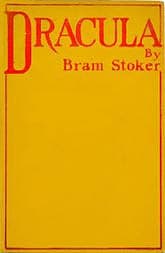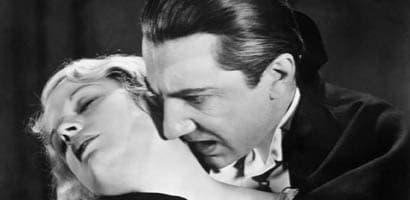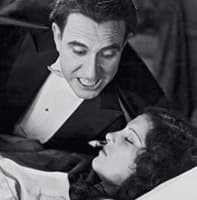Dracula
Critique • Quotes • Text • Dracula at the movies
 First edition
First editionFirst publication
1897
Literature form
Novel
Genres
Literary, fantasy
Writing language
English
Author's country
England
Length
Approx. 180,000 words

Bela Lugosi in classic neck-biting mode in the classic 1931 movie of Dracula.
Forever Dracula
Dracula (1931): Film, 75 minutes; director Tod Browning; writers Hamilton Deane, John L. Balderston; variably featuring Bela Lugosi, Helen Chandler, David Manners, Dwight Frye, Edward Van Sloan
Drácula (1931): Film, 104 minutes; director George Melford; writers Hamilton Deane, John L. Balderston, Baltasar Fernández Cué; featuring Carlos Villarías, Lupita Tovar, Pablo Álvarez Rubio
The most famous talking Dracula is actually only half a step away from being a silent film.
The 1931 Hollywood movie with Bela Lugosi as the undead count was directed by Tod Browning, whose experience as a silent-era veteran shows: long stretches of melodramatic lighting, exaggerated facial acting and the villain swooping across stage, without anything being said, or without even much of a musical score. (In 1999 the film was re-released with a new score by Philip Glass.)
Strictly speaking, this Dracula is not a direct adaptation of the novel either, but rather of a play, based on the book, by one Hamilton Deane and revised by John L. Balderston for Broadway production. The drama turned Count Dracula into a suave, old-world, romantic figure. Lugosi, who was born in part of Hungary that later became Romania, fit the bill perfectly on Broadway with his heavy accent and devilish but dignified manner. He wasn't the first choice to carry the role into the film (Lon Chaney, who was, died before filming) but Lugosi eventually got the part. And a legend was born.
Forever after, cinematic vampires have had to struggle against the type established by Lugosi. Two images in particular are indelible.
Dracula on the staircase of his spider-webbed castle delighting in the wolf howls. "Listen to them, the children of the night—what music they make!"
And that lustful image of the cloaked vampire leaning over the bed of a young woman, baring his teeth at her neck.
These scenes like many others are similar to those in the novel, but are enhanced by the brilliant sweeping camera work of cinematographer Karl Freund, another German expressionist, who some say directed the film more than Browning.
Much else has changed however in the transition from novel to play to rewritten play to screenplay. It is Renfield's, not Harker's, visit to Transylvania that is dramatized at the beginning, as Harker never leaves England. The death of Lucy comes quickly and there's a lot of mushy drama concerning Mina, who is saved by Van Helsing while Harker does very little besides fawn over her. There's no dramatic chase scene either in London or Transylvania. Much of the action is very stagy—people standing around, glaring at each other.
We never see the count turn into a wolf and his transformation into a bat is clumsy by standards of even ten years later. Anyone seeing that so-called bat bouncing around on the end of a fishing line today would laugh rather than flee in fright. But whenever Lugosi appears we forget all that nonsense.
It's often said that an actor owns a role but it's never been more true than with Lugosi playing Dracula. It's not that he's a great actor—he's not even as good as most others who donned the cloak after him. But he was a perfect match for the role at that time: with a few hammy gestures and a gleam in his eyes, he elevated the evil character of the book to the enchantingly evil character of the movies.
Such was his identification with the role that it's surprising to discover, despite all the sequels and remakes, Bela Lugosi never appeared as the count again after the first Dracula, except for a comedic minor role in Abbott and Costello Meet Frankenstein (1948).
The vampire in society: a scene from 1931's Dracula, starring Bela Lugosi.
But Lugosi isn't the only stand-out in Dracula. Dwight Frye as Renfield is as mesmerizing in his over-the-top insanity as Lugosi is in his evil. Edward Van Sloan is a decent old-school Van Helsing who gets to drive in the final stake. Bit of an anti-climax that though. The movie's over before we can really appreciate it.
One theory holds that the appeal of the novel Dracula arises from it being an allegory for the decaying hold of the aristocracy, those of noble bloodlines, on the emerging middle and working classes in the 1800s. Our modern heroes of doctors and other professional men of science finally put a stake through the heart of the old superstitions, to break the ties that try to drag us back from the Enlightenment to medieval times. Hollywood's Dracula, featuring Lugosi's seductive old-world charm, may be seen as confirmation of that interpretation. (We'll see other theories propounded through Dracula-related films in later years.)
Dracula, olé
At the same time as Dracula was being shot in English at Universal Studios, a Spanish version was also being made—on the same sets with the same screenplay (translated into español) but with all different actors. The English-speaking crew worked during the day and the Spanish at night.
And guess what? The Spanish version is actually better.
Drácula cleverly improves almost every scene over its English counterpart, a few cuts here and there, a few additions now and then, more dramatic staging.
It also runs nearly thirty minutes longer, allowing for more plot and character development.
It even has better effects, which is surprising, given its lower budget and tighter shooting schedule.
Spanish actor Carlos Villarías was apparently encouraged to copy Lugosi's moves as the vampire, despite not having the commanding presence of Lugosi—a couple of times he seems almost comical to the non-Spanish viewer. But for the most part he works well enough.
Mexican-born Lupita Tovar is sexier as Eva (as Mina is called in this version), despite being only twenty years old when the film was made.
Pablo Álvarez Rubio is equally, if not more, over the edge as Renfield, and would go on to have a long career, mainly—but not exclusively—in Spanish-language films.
This flick also is worth watching, especially in versions where you can choose the language of subtitles.
— Eric
Critique • Quotes • Text • At the movies
1922, 1931, 1936–1945, 1958, 1960–1974, 1979, 1979–1995, 1992, 2000, 2000, 2006, 2023


